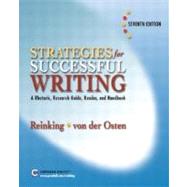
| Preface | p. xiii |
| To the Student | p. xx |
| Rhetoric | p. 1 |
| Writing: A First Look | p. 3 |
| The Purposes of Writing | p. 4 |
| The Audience for Your Writing | p. 6 |
| The Qualities of Good Writing | p. 10 |
| Writing and Ethics | p. 10 |
| Strategies for Successful Reading | p. 13 |
| Orienting Your Reading | p. 13 |
| A First Reading | p. 14 |
| Additional Readings | p. 15 |
| Mastering Reading Problems | p. 17 |
| Reading to Critique | p. 18 |
| Reading As a Writer | p. 18 |
| The Appeal of the Androgynous Man | p. 20 |
| Writing About What You Read | p. 22 |
| Planning and Drafting Your Paper | p. 26 |
| Understanding the Assignment | p. 27 |
| Zeroing In on a Topic | p. 27 |
| Gathering Information | p. 34 |
| Organizing the Information | p. 36 |
| Developing a Thesis Statement | p. 39 |
| Writing the First Draft | p. 42 |
| Planning and Drafting with a Word Processor | p. 45 |
| Revising and Editing Your Paper | p. 47 |
| Preparing to Revise | p. 48 |
| Considering the Whole Essay | p. 48 |
| Strengthening Paragraph Structure and Development | p. 54 |
| Sharpening Sentences and Words | p. 55 |
| Proofreading Your Draft | p. 57 |
| Writing the Introduction and Conclusion | p. 57 |
| Selecting a Title | p. 57 |
| Revising with a Computer | p. 60 |
| Peer Evaluation of Drafts | p. 61 |
| Collaborative Writing | p. 67 |
| Maintaining and Reviewing a Portfolio | p. 68 |
| Narration: Relating Events | p. 70 |
| Purpose | p. 71 |
| Action | p. 71 |
| Conflict | p. 72 |
| Point of View | p. 73 |
| Key Events | p. 74 |
| Dialogue | p. 75 |
| Ethical Issues | p. 76 |
| Writing a Narrative | p. 77 |
| Sample Student Essay of Narration: The Beach Bum | p. 78 |
| CriticalEdge | p. 82 |
| Description: Presenting Impressions | p. 84 |
| Purpose | p. 85 |
| Sensory Impressions | p. 85 |
| Dominant Impression | p. 87 |
| Vantage Point | p. 87 |
| Selection of Details | p. 89 |
| Arrangement of Details | p. 90 |
| Ethical Issues | p. 90 |
| Writing a Description | p. 91 |
| Sample Student Essay of Description: The Big One | p. 93 |
| Critical Edge | p. 95 |
| Process Analysis: Explaining How | p. 97 |
| Kinds of Process Analysis Papers | p. 98 |
| Ethical Issues | p. 100 |
| Writing a Process Analysis | p. 100 |
| Sample Student Essay of Process Analysis: The ABCs of CPR | p. 104 |
| Critical Edge | p. 107 |
| Illustration: Making Yourself Clear | p. 109 |
| Selecting Appropriate Examples | p. 110 |
| Number of Examples | p. 110 |
| Organizing the Examples | p. 111 |
| Ethical Issues | p. 112 |
| Writing an Illustration | p. 112 |
| Sample Student Essay of Illustration: If It Is Worth Doing | p. 114 |
| Critical Edge | p. 117 |
| Classification: Grouping into Categories | p. 119 |
| Selecting Categories | p. 120 |
| Number of Categories | p. 122 |
| Developing Categories | p. 122 |
| Ethical Issues | p. 123 |
| Writing a Classification | p. 124 |
| Sample Student Essay of Classification: Undesirable Produce Market Customers | p. 125 |
| Critical Edge | p. 127 |
| Comparison: Showing Relationships | p. 129 |
| Selecting Items for Comparison | p. 130 |
| Developing a Comparison | p. 131 |
| Organizing a Comparison | p. 132 |
| Using Analogy | p. 133 |
| Ethical Issues | p. 134 |
| Writing a Comparison | p. 135 |
| Sample Student Essay of Comparison: Different Shifts, Different Actions | p. 136 |
| Critical Edge | p. 139 |
| Cause and Effect: Explaining Why | p. 141 |
| Patterns in Causal Analysis | p. 141 |
| Reasoning Errors in Causal Analysis | p. 144 |
| Ethical Issues | p. 146 |
| Writing a Causal Analysis | p. 146 |
| Sample Student Essay of Cause and Effect: Why Students Drop Out of College | |
| Table of Contents provided by Publisher. All Rights Reserved. |
The New copy of this book will include any supplemental materials advertised. Please check the title of the book to determine if it should include any access cards, study guides, lab manuals, CDs, etc.
The Used, Rental and eBook copies of this book are not guaranteed to include any supplemental materials. Typically, only the book itself is included. This is true even if the title states it includes any access cards, study guides, lab manuals, CDs, etc.